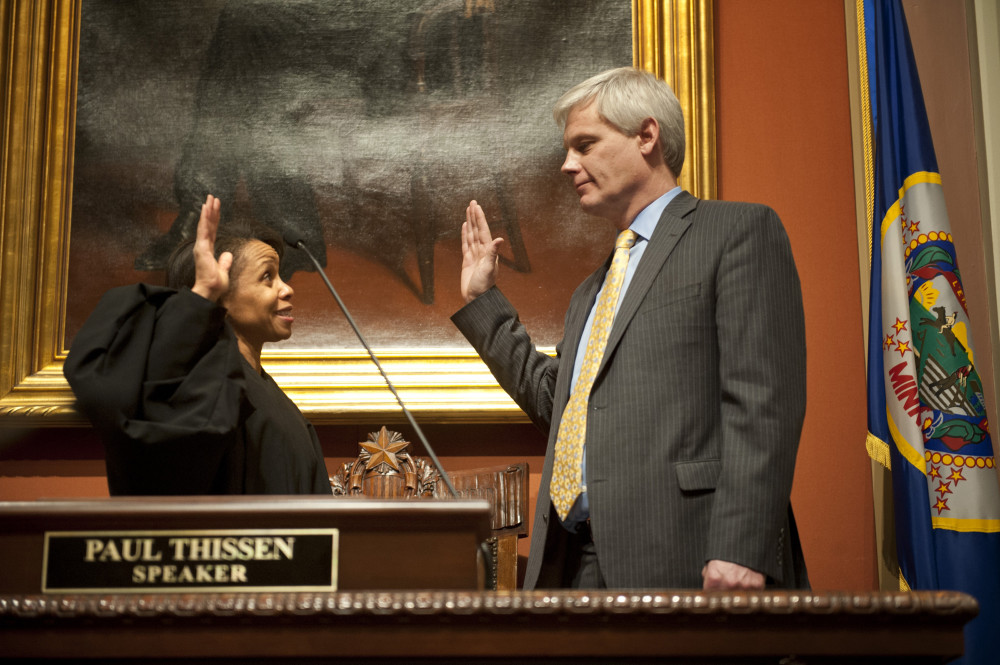EDITORIAL: A renewed effort to close Minnesota’s gender gap
Star Tribune (Minneapolis)
After nearly three dark years, the lights are back on at the Office on the Economic Status of Women in the Minnesota State Office Building.
It’s co-convening the first Minnesota Women’s Economic Security Summit in a long while Thursday in St. Paul, and several hundred participants are expected.
Among the presenters will be House Speaker Paul Thissen, armed with an ambitious package of 17 bills comprising the Minnesota Women’s Economic Security Act of 2014.
The speaker’s personal stamp on a set of initiatives is rare, and should serve to raise the package’s visibility and chances for enactment.
These are hopeful signs for working Minnesotans — of both genders — and for the children and elders who depend on them.
Economic fairness and opportunity for the female half of the population should be a priority in every legislative session.
When women climb economically, unimpeded by outdated thinking about roles and responsibilities, the whole state benefits.
But state leaders’ willingness to address Minnesota’s persistent gender gap in wages, educational attainment, housing, poverty and more has waxed and waned through the years.
The 38-year-old Office on the Economic Status of Women — a terrific source of data, research and nonpartisan guidance to legislators — was left in limbo from mid-2011 until a few weeks ago, when former lobbyist and public policy specialist Barbara Battiste took the office’s solo staff job.
We hope lawmakers have learned that ignoring the gender gap isn’t an effective strategy for closing it.
The summary of a report by the Center on Women and Public Policy and the Women’s Foundation of Minnesota says that “at the current rate, the pay gap in Minnesota will not be closed until 2060.”
The report describes the extent to which poverty in Minnesota has a female face — and, disproportionately, a face of color as well (see accompanying text).
While women make up half of the state’s workforce — among the highest percentages in the nation — they are two-thirds of the minimum-wage workers and 58 percent of those paid $9.50 or less.
That’s why a minimum-wage increase — from today’s $7.25-per-hour federal floor (which a majority of the state’s employers must pay) to $9.50 — tops the list of policy prescriptions that Thissen will bring to Thursday’s summit.
This newspaper favors a somewhat smaller increase this year, with more frequent boosts subsequently.
But we share Thissen’s view that a raise is overdue for low-wage workers and that market forces aren’t sufficient to raise wages in female-dominated service and caregiving occupations.
We also admire these items on Thissen’s list:
— Expanded parenting leave opportunities for working families. Minnesota law now requires small employers to offer workers up to six weeks of unpaid leave after the birth of a child, not before. That’s not enough. Raising that requirement to 12 weeks, and allowing an employee to take some of that time off before a birth, would give young families a less-stressful start.
— More paid sick leave for low-income workers. Today, 41 percent of Minnesota’s employees lack paid sick leave — and of that group, 72 percent are women, said state Rep. John Lesch, DFL-St. Paul. That’s why his bill to allow workers to earn one hour of paid leave for every 30 hours worked made Thissen’s list. Many of those without paid sick leave are child-care and food-service workers, Lesch noted. Denying them a chance to stay at home when they are sick endangers public health.
— A boost in child-care funding to allow more working families to afford high-quality care. That boost could take several forms. Early-learning scholarships for quality preschool programs could be enriched; additional funding for sliding-fee child care could be targeted at counties with long waiting lists for that subsidy, and higher provider reimbursement levels — which are now shockingly low — could open more child-care slots to children from low-income families.
— Extending pay-equity reporting requirements to private businesses that contract with state government. Required reporting on gender pay gaps has proved to be a gradual but effective tool for closing them during the 30 years since the requirements were set for state and local governments. That landmark pay equity law was intended to influence private-sector pay patterns as well. Requiring government vendors to pay attention to their pay gaps would be consistent with that unmet goal.
Those are highlights on a wish list that extends to expanded educational opportunities, entrepreneurship support and more. It’s likely more than what can be accomplished in the short legislative session anticipated this year.
But when the goal is improved financial footing for half of the working population and their families, legislative ambition is a desirable quality.














































































































































































































































































































































































